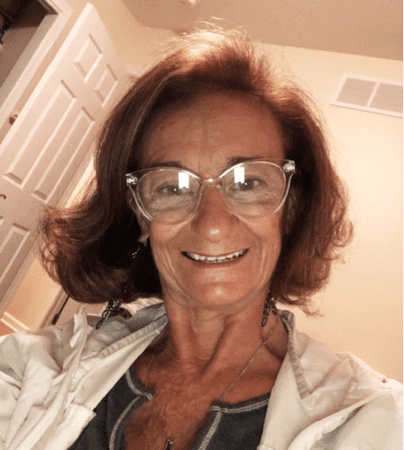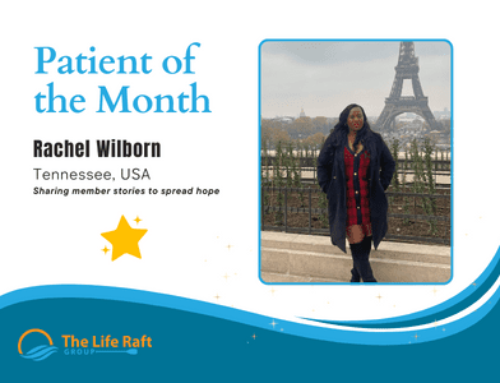As a part of our Faces of Courage series, we are featuring a patient or caregiver story each month. Each one of our members has a unique story to tell, but they all reflect the intrinsic courage of those who face the challenges of cancer head on, with dignity, strength, and passion for life.
Our Patient of the Month for May is Pamela Trovato Nau. Here is her story:
GISTory

Pamela Trovato Nau, Ohio, USA
In 1987, at 32 years of age and married with two small children, I began having intermittent abdominal cramping, which I thought at first was just an intestinal virus. However, the pain persisted over a month and I became concerned and contacted my physician. He ordered a barium swallow under fluoroscopy 1. This procedure ending up lasting eight hours, which normally takes about an hour to complete. As I was standing behind the fluoroscopy machine, the physician and two technicians were looking at me with a frightening stare on their faces: “a deer in headlights” type of look. The physician said throughout his career he had never seen anything like this before. As it turned out, my small intestines were full of submucosal masses ranging from the size of a pea to the size of a golf ball.
My next step was to make an appointment with a surgeon who in turn, ordered a CT scan. The CT scan showed these masses and small grape-like nodules on the back of my stomach. The physicians back then were not aware of GIST disease. I was scheduled for a laparotomy with excision of gastric and small bowel masses on January 27, 1987. The surgeon was totally unaware of what was growing in my abdomen. He had eight other surgeons and three pathologists in the surgical suite with him, all stumped about what they were witnessing. The surgeon removed six feet of the ileum which had intussuscepted 2 and became necrotic, and this was the reason for the intermittent cramping I had been experiencing. A small section of the liver was taken and sent off for pathology at five different testing sites as well.
The first report came back in June 1987 with the following findings: “In the differential diagnosis are malignant schwannoma 3, leiomyosarcoma, gonadal stromal tumor and multiple hamartomas 4.”
The second report came back in July 1987 and stated “I have no firm convictions on the histologic changes occurring in the stomach and small intestines. My only thought would be that it represents a multicentric leiomyoblastoma of the stomach and small intestines. From the extensive nature of the tumor, I doubt that the patient will do well, but to call it neoplastic from the histologic standpoint would be difficult.”
The third report came back in August 1987 and stated “I would suggest a CAT scan of her chest, abdomen and thighs to see if there is a mass somewhere of a primary tumor. If a mass is found, it should be surgically removed. Following that chemotherapy would be appropriate. If nothing is found on the CT scan, then chemotherapy should be started now. As you know the prognosis here is very poor.”
At the end of August, my slides and I were sent to a hospital in New York. Their findings were as follows: “High grade, round cell, lipoblastic liposarcoma 5.
By this time, I was referred to a local oncologist. He started chemotherapy on my very first visit. I received Vincristine, Cytoxin, DTIC, and Adriamycin – all of the “big guns”. Despite the prognosis being poor, the oncologist decided to start treatment since I still had small children at home. He figured it would allow me some time to spend with them. Little did he know, it was not pleasant after all.
I received chemotherapy for a total of nine months. During this time, my condition continued to decline. By October of 1987, I weighed 88 pounds and thought if I saw Christmas, it would be my last. I was in and out of the hospital several times in reverse isolation for leukopenia (low white blood count). The normal WBC (white blood count) is 5-10 thousand and mine was 900. I was placed on hyperalimentation for nutrition and developed gallstones from all the lipids I was receiving. I ended up having a cholecystectomy to remove my gallbladder and did well after that procedure. I was well enough to return to work after six weeks post-op. I was on a “work trial period” according to Social Security Administration. I was only allowed to work three days a week. Did I mention my profession is a registered nurse?! Of course, as we have all heard “bad things happen to nurses and doctors.” And boy was this true for me.
I continued to work while receiving SS disability, which by the way was denied at first. When I returned to full-time employment, I gave the updated diagnosis to Social Security and was told I’d have to repay the $10,000 I had received in my benefits. As you could imagine, I was literally sick to my stomach about this information, so I decided to write a three-page letter to them stating why I was disabled: I received chemo five days a week every month, which was accompanied by vomiting every day, lost my hair, had extreme fatigue and weight loss, not to mention the mental, spiritual and medical anguish I sustained. After that letter I never heard another word about returning my disability income.
By April of 1988, after receiving chemotherapy for nine months and hyperalimentations, my muscle mass was improving and not wasting away, and in fact I had gained my weight back. As you well know, cancer patients usually lose weight and continue to decline. Moving right along, trying to stay positive, healthy and hopeful, I then developed another intussusception in August 1999. Another four feet of small intestines were removed and then back to work I went with the tumors still growing inside of me.
I had been doing a lot of research on my condition and happened to come across information about Dr. Aiden Carney, a renowned GIST specialist and researcher. I took it upon myself to contact him to see if he would review my pathology slides and decide if I qualified as a Carney’s Triad patient, a disease named after him since he diagnosed the disease. He graciously accepted the challenge. He consulted with a genetic physician at NIH, Dr. Constantine Stratakis, and along with another physician they came up with the following diagnosis: “Stromal tumors with a low malignancy potential.” As a result of their findings, they decided to write a case study on my condition which was later published in the American Journal of Surgical Pathologists (Sept. 2008 edition).
Continuing with my career and no other adverse effects from the remaining tumors, I remained asymptomatic for several years. Then, while I was working in a surgery department as a circulator, I noticed every evening my abdomen was bloated, and I looked like I was nine months pregnant. I was working with a younger general surgeon at this time and we started discussing GIST disease. To his surprise, he asked me how I knew about that condition. I told him I was diagnosed with it in 2008. He suggested I have another CT scan and proceed from there. He reviewed the results and recommended that I have the tumors removed. He scheduled me for a laparotomy to remove the remaining tumors. At this time, four feet of my small intestines were removed along with a Roux-en-Y procedure. These tumors weighed 20 lbs. No chemotherapy was needed but he suggested I obtain an appointment with a local oncologist, whom I still see to this day. After visiting with her, she wanted me to see a GIST specialist. I now see him yearly to have CT scans done and I see my local oncologist every six months in between seeing the specialist.
My local oncologist wanted me to go on Gleevec at this time, but I decided not to take it given all the side effects I read about. In 2014 another tumor surfaced on the duodenum but did not require surgery. At this time I started on Gleevec 400 mg daily. Up to this date, my CT scans have shown positive results with tumor shrinkage and no evidence of further tumors.
Coping with GIST
I am a devoted Christian and I have a tremendous amount of faith in My Lord and Savior. As a nurse and a patient, I have accepted the fact that death is part of life and if I am called home today, I am satisfied with the life I have been blessed with. I have two beautiful children and three healthy grandchildren. I joined the GIST Survivor Facebook group in 2009 and discovered the Life Raft Group just this year. When I was asked to be the “Patient of the Month,” I was excited and honored they would want to publish my story. Without these two groups I do not know what I’d do without all of their prayers, stories, comments and knowledge.
Advice for Fellow GIST Patients
My advice to other GISTers is to become aware of your diagnosis and know your mutation. I am PDGFRA exon 12 with CKIT/CD117 positivity in my pathology staining. If you do not have very much knowledge about your disease process, I highly recommend obtaining a patient advocate. This person should be able to speak on your behalf, go with you to your oncology visits and helps you to understand just exactly what the physician is explaining to you.
Hobbies I Enjoy
I enjoy sewing, making quilts and watching movies!
Motto
I have two! My first motto is ” Yesterday is the past, the future isn’t here yet and tomorrow is not promised that’s why it’s called “the present.” And the second one is “Dance as if no one was looking, sing as no one was listening and live everyday to the fullest.”
I continue to pray for all my GIST family and enjoy sharing my story so others will seek information about their disease, ask questions and be proactive in their medical care. God bless all of you and please remain positive!!!
References
1 Fluoroscopy is a type of medical imaging that shows a continuous X-ray image on a monitor, much like an X-ray movie. During a fluoroscopy procedure, an X-ray beam is passed through the body. The image is transmitted to a monitor so the movement of a body part or of an instrument or contrast agent (“X-ray dye”) through the body can be seen in detail. (FDA)
2 Intussusception (in-tuh-suh-SEP-shun) is a serious condition in which part of the intestine slides into an adjacent part of the intestine. This telescoping action often blocks food or fluid from passing through. Intussusception also cuts off the blood supply to the part of the intestine that’s affected. This can lead to a tear in the bowel (perforation), infection and death of bowel tissue. (Mayo Clinic)
3 Schwannoma is a rare type of tumor that forms in the nervous system. Schwannoma grows from cells called Schwann cells. Schwann cells protect and support the nerve cells of the nervous system. Schwannoma tumors are often benign, which means they are not cancer. But, in rare cases, they can become cancer. (National Cancer Institute)
4 A hamartomav is a congenital tumor composed of tissues normally found in the involved area, in contrast to a choristoma, which is a congenital tumor composed of tissues not normally present in the involved area. (Science Direct)
https://www.sciencedirect.com/topics/medicine-and-dentistry/hamartoma
5 Liposarcoma is a rare type of cancer that begins in the fat cells. Liposarcoma is considered a type of soft tissue sarcoma. (Mayo Clinic)
Each member story reflects the individual patient’s experience. GIST is not one disease, but a family of diseases and each patient has a unique set of symptoms and manifestation of the disease.
Criteria for Patient of the Month
- Patient must be a member of the LRG GIST Patient Registry
- Patient is an active member of the Patient Registry, continually providing medical updates
- Patient’s record should be at least 80% up-to-date
- Patient has GIST Patient Registry Online
- Patient must agree to provide consent to share his/her story to our GIST community on our website and social media
Criteria for Caregiver of the Month
Caregivers are an important team of family and friends. They allow a patient to depend on them for support through their difficult journey as well as help with various tasks such as cooking, housekeeping, transportation and so much more. In conjunction with Life Raft Group’s Patient of the Month, we are showcasing Caregivers of the Month. We want to hear stories of the selfless supporters that stand beside our GIST warriors.
Interested? Contact Sahibjeet Kaur, LRG Patient Registry Supervisor, for more information: skaur@liferaftgroup.org




